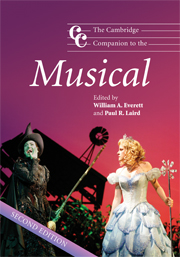Book contents
- Frontmatter
- Part I Adaptations and transformations: before 1940
- 1 American musical theatre before the twentieth century
- 2 Non-English-language musical theatre in the United States
- 3 Birth pangs, growing pains and sibling rivalry: musical theatre in New York, 1900–1920
- 4 American and British operetta in the 1920s: romance, nostalgia and adventure
- 5 Images of African Americans: African-American musical theatre, Show Boat and Porgy and Bess
- 6 The melody (and the words) linger on: American musical comedies of the 1920s and 1930s
- Part II Maturations and formulations: 1940–1970
- Part III Evolutions and integrations: after 1970
- Part IV Legacies and transformations
- Notes
- Select bibliography
- Index
5 - Images of African Americans: African-American musical theatre, Show Boat and Porgy and Bess
from Part I - Adaptations and transformations: before 1940
Published online by Cambridge University Press: 28 September 2011
- Frontmatter
- Part I Adaptations and transformations: before 1940
- 1 American musical theatre before the twentieth century
- 2 Non-English-language musical theatre in the United States
- 3 Birth pangs, growing pains and sibling rivalry: musical theatre in New York, 1900–1920
- 4 American and British operetta in the 1920s: romance, nostalgia and adventure
- 5 Images of African Americans: African-American musical theatre, Show Boat and Porgy and Bess
- 6 The melody (and the words) linger on: American musical comedies of the 1920s and 1930s
- Part II Maturations and formulations: 1940–1970
- Part III Evolutions and integrations: after 1970
- Part IV Legacies and transformations
- Notes
- Select bibliography
- Index
Summary
Soon after the end of slavery, African Americans formed musical troupes to sing, dance and act in a variety of shows. One of the first black companies was the Georgia Slave Troupe Minstrels, which was organised in April 1865 by a white manager, W. H. Lee. Another Georgia Minstrels company was organised in Indianapolis, under the management of a black performer, Charles B. Hicks; his company was to achieve fame as the foremost African-American minstrel troupe of the latter part of the nineteenth century. In these shows, African Americans followed the practice of established white troupes: they darkened their faces with burnt cork; staged burlesques on popular operas and operettas of the time, such as Jacques Offenbach's The Grand Duchess of Gerolstein; performed farces, such as Mr Jinks; pranced through eccentric and grotesque dances; and sang dialect, plantation and well-known minstrel songs both as solos and as ensemble pieces. The novelty of the black minstrel show was the race of the performers – the Georgia Minstrels, for example, advertised that in their shows the black performers were offering audiences a glimpse of ‘genuine’ plantation music and dance.
Not all black troupes during the 1870s and 1880s, however, were of the burnt cork minstrel variety. The Hyers sisters, Anna Madah (1855–1920s) and Emma Louise (1857–?99), performed operatic excerpts, art and parlour songs, and jubilee songs and spirituals during their concert tours in the first half of the 1870s. From 1876 to 1883 the sisters performed as part of the ‘Hyers Sisters Combination’, managed by their father, Samuel B. Hyers.
- Type
- Chapter
- Information
- The Cambridge Companion to the Musical , pp. 89 - 102Publisher: Cambridge University PressPrint publication year: 2008
- 2
- Cited by



